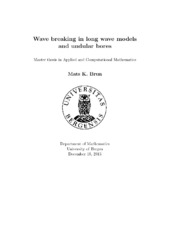| dc.description.abstract | Bores are a well known phenomena in fluid mechanics, although their occurrence in nature is relatively rare. The circumstances in which they occur is usually when a tidal swell causes a difference in surface elevation in the mouth of a river, or narrow bay, causing long waves to propagate upstream. The term 'tidal bore' is also frequently used in this context. Depending on the conditions the bore may take on various forms, ranging from a smooth wavefront followed by a smaller wave train, to one singe breaking wavefront. Some noteworthy locations where tidal bores can be found include the River Seine in France, the Petitcodiac River in Canada, and the Qiantang River in China. Common for all these locations is a large tidal range. Bores, when powerful enough, can produce particularly unsafe environments for shipping, but at the same time popular opportunities for river surfing. As found by Favre in 1935 by wave tank experiments, the strength of the bore can be determined by the ratio of the incident water level above the undisturbed water depth to the undisturbed water depth. Denoting this ratio by \(\alpha\), bores can occur in one of three categories: If \(\alpha\) is less than 0.28 the bore is purely undular, and will feature oscillations downstream of the bore front. If \(\alpha\) is between 0.28 and 0.75 the bore will continue to feature oscillations, but one or more waves behind the bore front will start to break. If \(\alpha\) is greater than 0.75 the bore is completely turbulent, and can no longer be described by the standard potential flow theory. The goal of this report is to simulate the time evolution of an undular bore through numerical experiments, using a dispersive nonlinear shallow water theory, in particular the Korteweg-deVries (KdV) equation. This is a third order nonlinear partial differential equation, where the dependent variable describes the displacement of the free surface. When deriving this equation, an expression for the velocity field of the flow is also available. This can be calculated at any point in the fluid, as long as the displacement of the surface is known. Thus, solving the KdV equation also yields the fluid particle velocity field, which can be used to calculate fluid particle trajectories, as done by Bjørkvåg and Kalisch, but also to formulate a breaking criterion. By applying this breaking criterion to the undular bore, the onset of breaking, and thus also a maximum allowable wave height (due to the nonlinearity of the model equation), can be computed numerically. This criterion can also be applied to the exact traveling wave solutions of the KdV equation, namely the 'solitary wave' solution and the 'cnoidal wave' solution. These are waves of constant shape traveling at constant velocity, thus applying the breaking criterion yields a maximum height for which they can exist. The theory leading to the formulation of the KdV equation is also included, in addition to formulation of the linearized and shallow water equations. These, however, serve only as 'stepping stones' towards the higher order Boussinesq equations, and are not used in any further calculations. | en_US |
